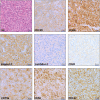Extramedullary plasmacytoma: Tumor occurrence and therapeutic concepts-A follow-up
- PMID: 35578404
- PMCID: PMC9761078
- DOI: 10.1002/cam4.4816
Extramedullary plasmacytoma: Tumor occurrence and therapeutic concepts-A follow-up
Abstract
Background: Extramedullary plasmacytoma (EMP) is a solitary tumor consisting of neoplastic plasma cells, with very little to no bone marrow involvement. EMPs are usually located in the head and neck region, but can also occur along the digestive tract, in lungs, or extremities.
Methods: Following our publication on EMP, which appeared in 1999 (Cancer 85:2305-14), we conducted a literature search for EMP-related reports published between 1999 and 2021. The documented cases, as well as 14 of our own patients from the ENT Clinic Erlangen, were extensively analyzed.
Results: Between 1998 and 2021, 1134 patients with EMP were reported, for whom information about the tumor localization was available. Among those, 62.4% had EMP in the head and neck area and 37.6% in other body regions. Data on therapy were reported in 897 patients, including 34.3% who received radiation, 28.1% surgery, 22.6% a combination of surgery and radiation, and 15.9% another therapy. In 76.9% patients no recurrence or transformation to multiple myeloma (MM) was reported, 12.8% showed local recurrence and 10.2% developed MM. Radiotherapy alone was associated with a tendency for increased occurrence of MM. In patients with EMP of head and neck area, combination therapy (surgery and radiation) resulted in a 5-year overall survival rate of 98.3%, surgery alone of 92.4%, and radiotherapy of 92.7%.
Conclusions: Collectively, our analyses indicate that surgical resection alone can achieve long-term tumor control in patients with EMP, if the tumor can be removed within safe limits without causing serious functional impairment. However, if this is not certain, either radiation or a combination of surgery and radiation therapy is suggested as an effective means of local tumor control.
Keywords: extramedullary plasmacytoma; non-Hodgkin lymphoma; survival; therapy; tumor outcomes.
© 2022 The Authors. Cancer Medicine published by John Wiley & Sons Ltd.
Conflict of interest statement
The authors declare no conflict of interest.
Figures




References
-
- Schridde H. Weitere Untersuchungen über die Körnelungen der Plasmazellen. Centralblatt f Allg Pathologie. 1905;16:433‐436.
-
- Sucker C, Stockschlader M. Extramedullary plasmacytoma. Dtsch Med Wochenschr. 2002;127(4):153‐155. - PubMed
-
- Rosinol L, Beksac M, Zamagni E, et al. Expert review on soft‐tissue plasmacytomas in multiple myeloma: definition, disease assessment and treatment considerations. Br J Haematol. 2021;194(3):496‐507. - PubMed
-
- Swerdlow SH, Campo E, Harris NL WHO Classification of Tumours of Haematopoietic and Lymphoid Tissues (World Health Organization Classification of Tumours, Band 2). 2017.
Publication types
MeSH terms
LinkOut - more resources
Full Text Sources
Medical
Research Materials
Miscellaneous

